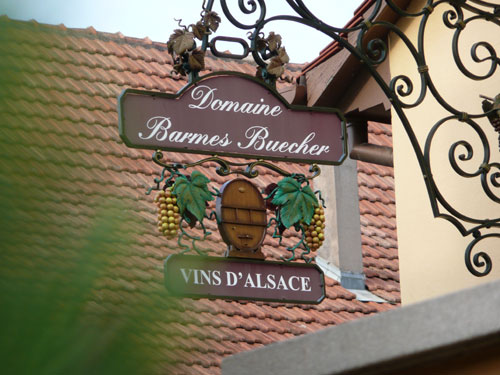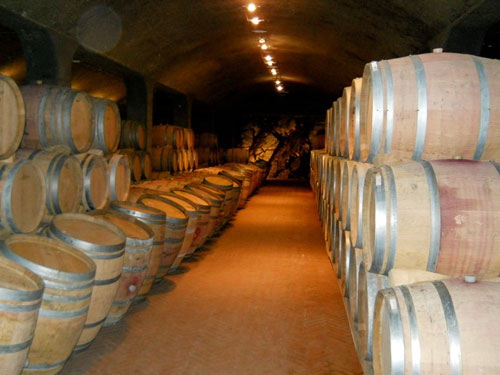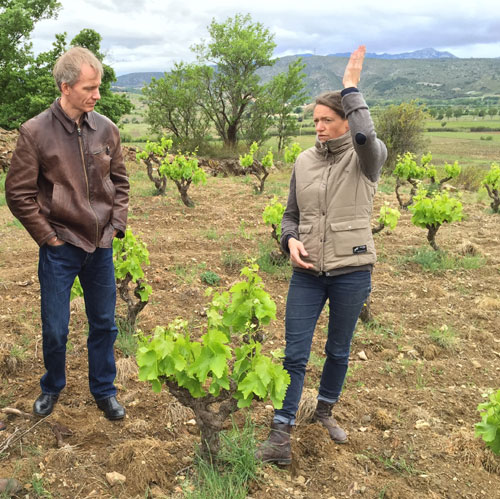|
The
most rewarding way I've learned about wine has been to visit vineyards
and meet with great vignerons. Those tours have been my postgraduate
symposia.
At its best, opening a bottle of wine
means decanting a delicious liquid as well as a kind of physical
poetry, but to visit a vineyard imparts a profound understanding of
the almost miraculous way the poetry gets in the glass.
To see vines hung with clusters of
grapes; observe tanks and vats where fermentation takes place; visit
cellars where newborn vintages sleep in barrels like babes in a
nursery; and then sit down with a winemaker and taste his or her
creations—well, when you do that you understand why wine has
been revered as a sacramental beverage for millennia and how the cult
of Dionysus swept across the ancient world.
Almost all my vineyard tours have been
part of the annual trips to Europe my friends and I have been making
for over 20 years. My first tour was at Domaine Barm猫s-Buecher in
Alsace, France in 2001, as auspicious an introduction as one could
ever receive.

There, in the village of Wettolsheim, we met the already-renowned
winemaker Fran莽ois Barm猫s and his wife, Genevi猫ve. (Tragically, Fran莽ois
was struck and killed by a car while out cycling in 2011.)
The eyes of Fran莽ois Barm猫s sparkled like sapphires, cinching his uncanny
resemblance to a leprechaun. He was a truly happy man, one of those rare
people who pursued his passion and was successful doing it. As a farmer
he found fulfillment in his closeness to the earth; as a vigneron he could
take ample pride in the literal fruits of his labor. He was way ahead of his
time too, choosing to farm biodynamically: no artificial fertilizers, no
pesticides, harvesting according to the moon's phases. He showed us, for
example, how he planted nettles around the trunks of his vines to thwart
unwanted visitors.
Some wine regions have comparatively few grapes, but Alsace teems with
varietals: Auxerrois blanc, Chasselas, Gewurtztraminer, Muscat, Riesling,
Sylvaner, Pinot Blanc, Pinot Gris, and Pinot Noir. Fran莽ois grew the lot.
And he regaled us with the mother of all wine tastings, pouring literally dozens of wines—Cremant d'Alsace, still wines of every different varietal,
the same varietal from three different parcels, Grand Cru selections, vendange tardive (late-harvest wines)—with no end in sight!
I'll never forget the great warmth and literally overflowing hospitality he
and Genevi猫ve showed us. To the Tolkien fan, Fran莽ois was Elrond and
Tom Bombadil rolled into one.
Over the years, I've been very lucky to meet some of Europe's best
winemakers. They have graciously given me and my fellow wine pilgrims
their time and insights, guiding us around their estates and sharing their
superb cuv茅es. And I've learned something new about this ancient art
every time.
At his beautiful Tuscan vineyard Isole e Olena, Paolo de Marchi, the famed
"Dean of Chianti," educated us in 2011 on the science and counterintuitive
subtleties of vine density, or how many vines one should plant in a given
space.

We visited Bordeaux in 2013. At Chateau Haut-S茅gottes in Saint Emilion
we met Madame Danielle Meunier. The spry octogenarian told us she had
worked with many a tonnelier, or cooper, and that the way they toast the
inside of an oak barrel with a torch can vary greatly, thus imbuing the wine
aged within them with more or less flavor. After years of experimentation,
she now had three coopers whose barrels met her exacting standards.
The next year we journeyed to southern France's Languedoc region where
the young couple Marjorie and St茅phane Gallet run their Domaine Le Roc
des Anges in the Rousillon appellation. Over some very rugged farm roads,
Marjorie drove us out to a parcel of Carignan vines planted in 1903.

She showed us how Carignan folds its leaves during the day's hottest hours
to conserve moisture, an extremely useful adaptation given the region's
scorching summer temperatures. Owing to this trait and the fact that such
old vines have root systems extending dozens of meters down into the
ground, she didn't have to bring supplemental water to the plot during dry
stretches; those incredible old Carignan vines were self-sufficient.
And in 2018 we had the rare pleasure of spending a good part of a great
day with master vignaiolo Giampero Bea at his vineyard in Umbria. He
made such an impression on me that I wrote a piece about him for this
magazine the same year. Along with his magnificent wines (especially
those Montefalco reds based on Sagrantino), he shared several insights that
wonderfully illustrate how a winemaker is a farmer, a scientist, and an
artisan:
He told us, for example, of how a fungus began to mysteriously afflict a
neighboring vineyard when the proprietors pushed their plantings
further down the valley. Giampero smiled and shook his head. There
was no mystery; his neighbors forgot what their ancestors had figured
out: above a certain elevation the vines were safe from harmful fungus.
This kind of continuing education in wine—a total understanding of the
land, grapes, facilities, cuv茅es, and the people who put their souls into
making oenological magic—is wonderfully chronicled in the memoirs of
America's two greatest living wine merchants: Neal Rosenthal's Reflections
of a Wine Merchant and Kermit Lynch's Adventures on the Wine Route.
Of course, the daily enjoyment of wine with family and friends constitutes
its own ongoing education: we taste, we share, we learn. More than
anything else, the most valuable knowledge I've attained as a connoisseur
is how to enjoy wine at every level and pair it well with foods as well as
moods.
Friedrich H枚lderlin has those lines in his great ode, "The Rhine," in which
he asserts:
With wine, as with life, we never stop being students.
|